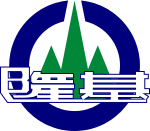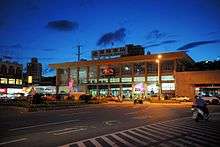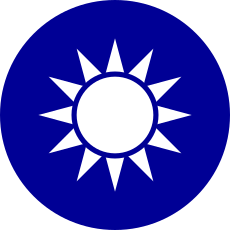Keelung
| Keelung 基隆市 | |||
|---|---|---|---|
| Provincial city | |||
 | |||
| |||
| Nickname(s): The Rainy Port (雨港) | |||
 | |||
| Coordinates: 25°08′N 121°44′E / 25.133°N 121.733°ECoordinates: 25°08′N 121°44′E / 25.133°N 121.733°E | |||
| Country | Taiwan | ||
| Region | Northern Taiwan | ||
| Districts | 7 | ||
| City seat | Zhongzheng District | ||
| Government | |||
| • Mayor | Lin Yu-chang (DPP) | ||
| • Deputy Mayor | Lin Yong-fa[1] | ||
| Area | |||
| • Total | 132.7589 km2 (51.2585 sq mi) | ||
| Area rank | 18 of 22 | ||
| Population (2016)[2] | |||
| • Total | 371,878 | ||
| • Rank | 16 of 22 | ||
| • Density | 2,800/km2 (7,300/sq mi) | ||
| Time zone | National Standard Time (UTC+8) | ||
| Postal code | 200-206 | ||
| Area code(s) | (0)32 | ||
| - Bird | Eagle | ||
| - Flower | Common crepe myrtle | ||
| - Tree | Formosan Sweet-gum | ||
| English | Keelung/KLC | ||
| Chinese | 基隆/基市 | ||
| Website | www.klcg.gov.tw | ||
| Keelung | |||||||||||||
| Chinese name | |||||||||||||
|---|---|---|---|---|---|---|---|---|---|---|---|---|---|
| Chinese | 基隆市 | ||||||||||||
| |||||||||||||
| Taiwanese Hokkien Name | |||||||||||||
| Traditional Chinese | 雞籠市 | ||||||||||||
| Simplified Chinese | 鸡笼市 | ||||||||||||
| |||||||||||||
| Japanese name | |||||||||||||
| Kanji | 基隆市 | ||||||||||||
| Kana | キールンし | ||||||||||||
| |||||||||||||
Keelung, officially known as Keelung City (Chinese: 基隆市; pinyin: Jīlóng Shì), is a major port city situated in the northeastern part of Taiwan. It borders New Taipei with which it forms the Taipei–Keelung metropolitan area, along with Taipei itself. Nicknamed the Rainy Port for its frequent rain and maritime role, the city is Taiwan's second largest seaport (after Kaohsiung).
Name
According to early Chinese accounts, this northern coastal area was originally called Pak-kang (Chinese: 北港; Pe̍h-ōe-jī: Pak-káng).[3] By the early 20th century, the city was known to the Western world as Kelung,[4] as well as the variants Kiloung, Kilang and Keelung.[5] In his 1903 general history of Taiwan, US Consul to Formosa (1898–1904) James W. Davidson related that "Kelung" was among the few well-known names, thus warranting no alternate Japanese romanization.[6]
However, the Taiwanese people have long called the city Kelang (Chinese: 雞籠; Pe̍h-ōe-jī: Ke-lâng/Koe-lâng; literally: "rooster cage" or "hencoop"[7]). It has been proposed that this name was derived from the local mountain that took the shape of a rooster cage. However, it is more probable that the name was derived from the first inhabitants of the region, as are the names of many other Taiwanese cities. In this case, the Ketagalan people were the first inhabitants, and early Han settlers probably approximated "Ketagalan" with Ke-lâng (Hokkien phonetics).
In 1875, during the late Qing era, a new official name was given (Chinese: 基隆; pinyin: Jīlóng; literally: "base prosperous").[8] In Mandarin, probably the working language of Chinese government at the time, both the old and new names were likely pronounced Kīlóng (hence "Keelung").
Under Japanese rule (1895–1945), the city was also known to the west by the Japanese romanization Kīrun (also written as Kirun or Kiirun[9]).
In Standard Chinese, which became the official language of Taiwan after its handover to the Republic of China, the newer name is read Jīlóng (the shift from initial K to J is a recent development in the Beijing dialect, see Old Mandarin). However, the locals continue to call the city Ke-lâng across the changes in government.[10][11]
History
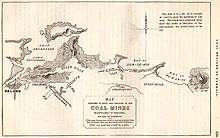
Keelung was first inhabited by the Ketagalan, a tribe of Taiwanese aborigine. The Spanish expedition to Formosa in the early 17th century was its first contact with the West; by 1624 the Spanish had built San Salvador de Quelung, a fort in Keelung serving as an outpost of the Manila-based Spanish East Indies.[12] The Spanish ruled it as a part of Spanish Formosa. From 1642 to 1661 and 1663–1668, Keelung was under Dutch control.[13][14] The Dutch East India Company took over the Spanish Fort San Salvador at Santissima Trinidad. They reduced its size and renamed it Fort Noort-Hollant.[14] The Dutch had three more minor fortifications in Keelung and also a little school and a preacher.
Kingdom of Tungning
When Ming Dynasty loyalist Koxinga successfully attacked the Dutch in southern Taiwan (Siege of Fort Zeelandia), the crew of the Keelung forts fled to the Dutch trading post in Japan. The Dutch came back in 1663 and re-occupied and strengthened their earlier forts. However, trade with Qing China through Keelung was not what they hoped it would be and, in 1668, they left after getting harassed by aboriginals.[15]
Qing dynasty
First Opium War
During the First Opium War between the British Empire and the Chinese Qing Empire, in the 1841 Battle of Keelung (1841-1842) the British attempted to attack in failed efforts three times against Keelung on the northeast coast of Taiwan under Qing rule.[16][17][18][19] Attempts by the British to seize Da'an and Keelung by the British failed[20] due to a successful defence led by the taotai Yao Ying who commanded the Chinese naval forces on Taiwan.[21] Indian and European crew members of the Nerbudda, a British ship, were captured on Taiwan after being abandoned by their British officers and were executed by local Qing officials.[22] Portuguese, Indian, American, and European crew members of the Ann, another British ship, were shipwrecked in the vicinity of Tamsui in March 1842, captured, and then executed by the Chinese.[23][24] At Tainan, 197 of the Nerbudda and Ann's crews were killed and due to causes related to imprisonment 87 others died.[25]
In 1863, the Qing Empire opened up Keelung as a trading port and the city enjoyed rapid development due to the abundant commodities such as placer gold and high quality coal found in the drainage area of Keelung River. In 1875, Taipeh Prefecture was created and included Keelung. In 1878, Keelung was formed into a ting or sub-prefecture.[26] Around the same time, the name was changed from Ke-lang (雞籠廳) to Kilong (基隆廳), which means "rich and prosperous land".[8]
Sino-French War
During the Sino-French War (1884–85), the French attempted an invasion of Taiwan during the Keelung Campaign. Liu Mingchuan, who led the defence of Taiwan, recruited Aboriginals to serve alongside the Chinese soldiers in fighting against the French of Colonel Jacques Duchesne's Formosa Expeditionary Corps. The French were defeated at the Battle of Tamsui and the Qing forces pinned the French down at Keelung in an eight-month-long campaign before the French withdrew.
Empire of Japan
A systematic city development started during the Japanese Era, after the 1895 Treaty of Shimonoseki, which handed all Taiwan over to Japan. A five-phase construction of Keelung Harbor was initiated, and in by 1916 trade volume had exceeded even those of Tamsui and Kaohsiung Harbors to become one of the major commercial harbors of Taiwan.[27]
Keelung was governed as Kīrun Town (基隆街), Kīrun District, Taihoku Prefecture in 1920 and was upgraded to a city in 1924.[27] The Pacific War broke out in 1941, and Keelung became one of the first targets of Allied bombers and was nearly destroyed as a result.[27]
Republic of China
After the handover of Taiwan to China from Japan in October 1945, Keelung was established as a provincial city of Taiwan Province. The Keelung City Government worked with the harbor bureau to rebuild the city and the harbor and in 1984, the harbor became the 7th largest container harbor in the world.[28]
Geography
Keelung City is located in the northern part of Taiwan Island. It occupies an area of 132.76 km2 and is separated from its neighboring county by mountains in the east, west and south. The northern part of the city faces the ocean and is a great deep water harbor since early times.[29]
Climate
Keelung has a humid subtropical climate (Köppen Cfa) with a yearly rainfall average upwards of 3,700 millimetres (146 in). It has long been noted as one of the wettest and gloomiest cities in the world; the effect is related to the Kuroshio Current.[30] Although it is one of the coolest cities of Taiwan, winters are still short and mild, whilst summers are long, dry and hot, temperatures can peek above 26 °C during a warm winter day, while it can dip below 27 °C during a rainy summer day, much like the rest of northern Taiwan. However its location on northern mountain slopes means that due to orographic lift, rainfall is heavier during fall and winter, the latter during which a northeasterly flow prevails. During summer, southwesterly winds dominate and thus there is a slight rain shadow effect. Fog is most serious during winter and spring, when relative humidity levels are also highest.
| Climate data for Keelung (1981–2010) | |||||||||||||
|---|---|---|---|---|---|---|---|---|---|---|---|---|---|
| Month | Jan | Feb | Mar | Apr | May | Jun | Jul | Aug | Sep | Oct | Nov | Dec | Year |
| Average high °C (°F) | 18.3 (64.9) |
18.8 (65.8) |
20.8 (69.4) |
24.4 (75.9) |
27.7 (81.9) |
30.7 (87.3) |
33.0 (91.4) |
32.3 (90.1) |
29.6 (85.3) |
26.2 (79.2) |
23.3 (73.9) |
19.9 (67.8) |
25.42 (77.74) |
| Daily mean °C (°F) | 16.0 (60.8) |
16.2 (61.2) |
17.9 (64.2) |
21.3 (70.3) |
24.5 (76.1) |
27.3 (81.1) |
29.3 (84.7) |
28.9 (84) |
27.0 (80.6) |
24.1 (75.4) |
21.2 (70.2) |
17.7 (63.9) |
22.62 (72.71) |
| Average low °C (°F) | 13.9 (57) |
14.2 (57.6) |
15.5 (59.9) |
18.8 (65.8) |
22.0 (71.6) |
24.6 (76.3) |
26.4 (79.5) |
26.2 (79.2) |
24.7 (76.5) |
22.2 (72) |
19.2 (66.6) |
15.7 (60.3) |
20.28 (68.52) |
| Average rainfall mm (inches) | 335.8 (13.22) |
399.1 (15.713) |
332.3 (13.083) |
240.9 (9.484) |
296.1 (11.657) |
286.7 (11.287) |
150.4 (5.921) |
212.8 (8.378) |
360.8 (14.205) |
413.4 (16.276) |
394.7 (15.539) |
332.1 (13.075) |
3,755.1 (147.838) |
| Average rainy days (≥ 0.1 mm) | 21.0 | 19.6 | 21.1 | 17.2 | 18.8 | 14.2 | 9.2 | 11.5 | 15.0 | 17.7 | 19.9 | 20.1 | 205.3 |
| Average relative humidity (%) | 81.2 | 82.5 | 83.6 | 81.6 | 81.7 | 79.6 | 75.1 | 76.7 | 78.6 | 79.2 | 79.0 | 78.5 | 79.8 |
| Mean monthly sunshine hours | 54.5 | 48.0 | 65.6 | 83.4 | 90.3 | 125.4 | 203.0 | 192.5 | 149.1 | 94.3 | 58.7 | 52.6 | 1,217.4 |
| Source: [31] | |||||||||||||
Administration
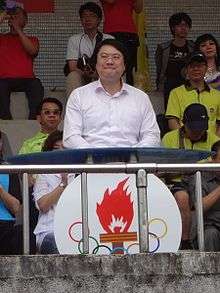
Zhongzheng District is the seat of Keelung City which houses the Keelung City Government and Keelung City Council. The current Mayor of Keelung is Lin Yu-chang of the Democratic Progressive Party.
Administrative divisions
| Keelung has seven districts (區 Qu): | District | Population | Land area | |
|---|---|---|---|---|
 |
as of 2016 | km² | ||
| ■ Zhongzheng | 中正區 | 52,689 | 10.2118 | |
| ■ Zhongshan | 中山區 | 48,369 | 10.5238 | |
| ■ Ren'ai | 仁愛區 | 45,563 | 4.2335 | |
| ■ Xinyi | 信義區 | 51,621 | 10.6706 | |
| ■ Anle | 安樂區 | 81,298 | 18.0250 | |
| ■ Nuannuan | 暖暖區 | 38,393 | 22.8283 | |
| ■ Qidu | 七堵區 | 54,086 | 56.2659 |
Politics
Keelung City voted one Democratic Progressive Party legislator to be in the Legislative Yuan during the 2016 Republic of China legislative election.[32]
Demographics and culture
| Historical population | ||
|---|---|---|
| Year | Pop. | ±% |
| 1897 | 9,500 | — |
| 1904 | 17,710 | +86.4% |
| 1924 | 58,000 | +227.5% |
| 1943 | 100,000 | +72.4% |
| 1944 | 92,000 | −8.0% |
| 1948 | 130,000 | +41.3% |
| 1971 | 330,000 | +153.8% |
| 1985 | 351,524 | +6.5% |
| 1990 | 352,919 | +0.4% |
| 1995 | 368,771 | +4.5% |
| 2000 | 388,425 | +5.3% |
| 2005 | 390,633 | +0.6% |
| 2010 | 384,134 | −1.7% |
| 2015 | 372,105 | −3.1% |
| Source: "Populations by city and country in Taiwan". Ministry of the Interior Population Census. | ||
Population growth
| Year | Population | Notes |
|---|---|---|
| |
|
|
| |
|
|
| |
|
Ranked 6th[33] |
| |
|
|
| |
|
|
| |
|
Decrease due to Allied air bombings |
| |
|
28,000 Mainlander influx |
| |
|
|
| |
|
|
| |
|
Festivals
One of the most popular festivals in Taiwan is the Mid-Summer Ghost Festival. The Keelung Ghost Festival is among the oldest in Taiwan, dating back to 1851 after bitter clashes between rivaling clans, which claimed many lives before mediators stepped in. The Ghost Festival of Keelung City is a reflection of Taiwan's rich cultural history that is very much alive today.[34]
Economy
Coal mining peaked in 1968. The city developed quickly and by 1984, the harbor was the 7th largest container harbor in the world.[28]
 Keelung Port Croquis (in 1894)
Keelung Port Croquis (in 1894) Keelung Landmark
Keelung Landmark

Education
Education in Keelung City is governed by the Department of Education of Keelung City Government.
Universities and colleges
Keelung City houses several universities and colleges, such as the National Taiwan Ocean University, Ching Kuo Institute of Management and Health and Chungyu Institute of Technology.
High schools
Energy
Keelung City houses the only fully oil-fired power plant in Taiwan, the Hsieh-ho Power Plant, which is located in Zhongshan District. The installed capacity of the power plant is 2,000 MW.
Tourist attractions
Ports
Parks
Chung Cheng Park, Ho Ping Island Hi Park.
Cultural centers
Museums
National Museum of Marine Science and Technology.
Historical structures
Baimiweng Fort, Dawulun Fort, Gongzi Liao Fort, Keelung Fort Commander's Official Residence, Pengjia Lighthouse and Uhrshawan Battery.
Transportation
Rail
The Taiwan Railways Administration stations of Badu Station, Baifu Station, Keelung Station, Nuannuan Station, Qidu Station and Sankeng Station cross Keelung City.
Water
Taiwan's second largest port, the Port of Keelung, is located in the city. The port serves for destinations to Matsu Islands, Xiamen and Okinawa.
International relations
Twin towns — Sister cities
Keelung is twinned with:
 Bacolod City and Davao City, Philippines
Bacolod City and Davao City, Philippines Bikini Atoll, Marshall Islands
Bikini Atoll, Marshall Islands Campbell, USA
Campbell, USA Corpus Christi, USA
Corpus Christi, USA East London, South Africa
East London, South Africa Marrickville, Australia
Marrickville, Australia Miyakojima, Japan
Miyakojima, Japan Rosemead, USA
Rosemead, USA Salt Lake City, USA
Salt Lake City, USA Thunder Bay, Canada
Thunder Bay, Canada Yakima, USA
Yakima, USA
People from Keelung
- Chen Ti, Taiwanese tennis player
- Zero Chou, Taiwanese director
- Jiang Yi-huah, Premier of the Republic of China
- Show Luo, Taiwanese entertainer
- Danson Tang, Taiwanese Mandopop singer
- Yi Huan, Taiwanese comic creator/animator
- Feng-hsuing Hsu, American-Taiwanese computer scientist
- Hsie Zhen-Wu, Taiwanese TV presenter/lawyer
- Fu-jie Guo, American-Taiwanese computer scientist
See also
References
- ↑ http://www.klcg.gov.tw/en/02/02_2.jsp
- ↑ 人口統計. www.klcg.gov.tw (in Chinese). Retrieved 6 June 2016.
- ↑ Campbell, William (1903). "Explanatory Notes". Formosa under the Dutch: described from contemporary records, with explanatory notes and a bibliography of the island. London: Kegan Paul. pp. 538–557. OCLC 644323041.
- ↑ for example: Smith, D. Warres (1900). European settlements in the Far East: China, Japan, Corea, Indo-China, Straits Settlements, Malay States, Siam, Netherlands, India, Borneo, the Philippines etc. S. Low, Marston & company. p. 38. OCLC 3110223. OL 6905314M.
- ↑ Davidson (1903), Index p.20.
- ↑ Davidson (1903), p. iii.
- ↑ "Welcome to Keelung City: The Beginning". Keelung City Government. Retrieved 2010-07-24.
- 1 2 "Ching Dynasty". Keelung City Government. Retrieved 2010-07-24.
- ↑ Terry, Thomas Philip (1914). Terry's Japanese Empire. Houghton Mifflin Company. p. 774. OCLC 51414323. OL 18847607M.
- ↑ Governor-General of Taiwan (1931–1932). "koe-lâng (基隆)". In Ogawa Naoyoshi. 臺日大辭典 [Taiwanese-Japanese Dictionary] (in Japanese and Hokkien). 1. Taihoku: 同府 [Dōfu]. p. 466. OCLC 25747241..
- ↑ "Entry #35351 (基隆市)". 臺灣閩南語常用詞辭典 [Dictionary of Frequently-Used Taiwan Minnan] (in Chinese and Hokkien). Ministry of Education, R.O.C. 2011.
- ↑ Altares, Guillermo (November 12, 2016). "Una excavación aporta una nueva visión de la colonización de Asia". El País (in Spanish). Retrieved November 13, 2016.
- ↑ Twitchett, Denis Crispin (1978). The Cambridge history of China, Volume 2; Volume 8. Cambridge University Press. p. 46. ISBN 9780521243339. OCLC 613665518.
- 1 2 "Ming Dynasty and Cheng Cheng kung's Era". Keelung City Government. Retrieved 2010-06-12.
- ↑ Shepherd (1993), p. 95.
- ↑ Elliott, Jane E. (2002). Some Did it for Civilisation, Some Did it for Their Country: A Revised View of the Boxer War. Chinese University Press. ISBN 9789629960667. p. 197
- ↑ http://taiwaninfo.nat.gov.tw/ct.asp?xItem=17470&ctNode=103&htx_TRCategory=&mp=4
- ↑ http://subtpg.tpg.gov.tw/Eng2/historic/link01.htm
- ↑ https://www.sinica.edu.tw/tit/scenery/0196_keelung.html
- ↑ Lai, J.Y. (2008). Cultural Identity and the Making of Modern Taiwanese Painting During the Japanese Colonial Period (1895-1945) (Ph.D.). University of Michigan. pp. 34–.
- ↑ http://library.globalchalet.net/Authors/Poetry%20Books%20Collection/Frontier%20Taiwan%20-%20An%20Anthology%20of%20Modern%20Chinese%20Poetry.pdf p. 9
- ↑ Shih-Shan Henry Tsai (18 December 2014). Maritime Taiwan: Historical Encounters with the East and the West. Routledge. pp. 66–. ISBN 978-1-317-46517-1.
- ↑ Manthorpe, Jonathan (15 December 2008). Forbidden Nation: A History of Taiwan. St. Martin's Press. pp. 129–. ISBN 978-0-230-61424-6.
- ↑ http://hiotuxliwisbp6mi. onion.link/video/torrents.complete/Nonfiction%201700%20Sorted%20Ebooks%20Pack%20PHC/1403969817.Palgrave.Macmillan.Forbidden.Nation.A.History.of.Taiwan.Oct.2005.pdf
- ↑ H. Maclear Bate (1952). Report from Formosa. Dutton. p. 174.
- ↑ Davidson (1903), p. 211.
- 1 2 3 "Japanese Occupation". Keelung City Government. Retrieved 2010-06-12.
- 1 2 "The Republic of China". Keelung City Government. Retrieved 2010-06-12.
- ↑ http://www.klcg.gov.tw/en/01/01_1.jsp
- ↑ Davidson, James W. (1903). "Appendix IV: Climate". The Island of Formosa, Past and Present : history, people, resources, and commercial prospects : tea, camphor, sugar, gold, coal, sulphur, economical plants, and other productions. London and New York: Macmillan. OL 6931635M.
- ↑ "Statistics > Monthly Mean". Central Weather Bureau.
- ↑ http://vote2016.cec.gov.tw/en/T1/n712010000000000.html
- ↑ Takekoshi, Yosaburō (1907). "Chapter XI II: Population and future development of the island resources". Japanese rule in Formosa. London, New York, Bombay and Calcutta: Longmans, Green, and co. p. 200. OCLC 753129. OL 6986981M.
- ↑ "Keelung: Mid-summer ghost festival". Dream Life. Retrieved 2008-10-15.
External links
 Keelung travel guide from Wikivoyage
Keelung travel guide from Wikivoyage- Keelung City Government official website (English)
- Keelung Harbor Bureau official website (English)
- WorldStatesmen.org — Taiwan

